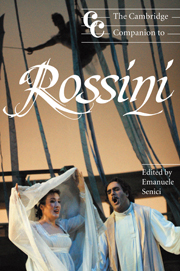Book contents
- Frontmatter
- 1 Introduction: Rossini's operatic operas
- Part I Biography and reception
- Part II Words and music
- 5 Librettos and librettists
- 6 Compositional methods
- 7 The dramaturgy of the operas
- 8 Melody and ornamentation
- 9 Off the stage
- Part III Representative operas
- Part IV Performance
- Notes
- List of works
- Bibliography
- Index
8 - Melody and ornamentation
from Part II - Words and music
Published online by Cambridge University Press: 28 September 2011
- Frontmatter
- 1 Introduction: Rossini's operatic operas
- Part I Biography and reception
- Part II Words and music
- 5 Librettos and librettists
- 6 Compositional methods
- 7 The dramaturgy of the operas
- 8 Melody and ornamentation
- 9 Off the stage
- Part III Representative operas
- Part IV Performance
- Notes
- List of works
- Bibliography
- Index
Summary
More than any other qualities of Rossini's operas, it was orchestration and melodic idiom that determined their success at the time of the first performances, and for us today they remain among the most significant aspects of the composer's art. While his orchestration displays distinctly novel tendencies, Rossini's melodic language is based on consolidation: an extreme refinement of two typically Italian traditions, the school of the castratos and the concertante aesthetic applied to the voice, coinciding historically with the disappearance of the first and the dwindling of the second. Rossini integrated into his writing for voices a system of expression perfectly suited to the training of the singers of his time. This continuity between Rossini's vocal grammar and that of his interpreters was crucial to the success of this art, and yet also precipitated its obsolescence when the performers, as time went on, lost the technical capacity to execute the proper diminutions and to ornament their own parts. But by that time Rossini's melodic language, directly as much as through singers, had already impregnated the music of numerous composers contemporary with, or immediately after, its progenitor. Even the most original among them – Donizetti, Bellini, Pacini, Mercadante, the young Verdi – had recourse to his style. It follows, then, that detailed knowledge of this style is a valuable tool in the study of all Italian opera in the first half of the nineteenth century.
- Type
- Chapter
- Information
- The Cambridge Companion to Rossini , pp. 104 - 123Publisher: Cambridge University PressPrint publication year: 2004
- 1
- Cited by



